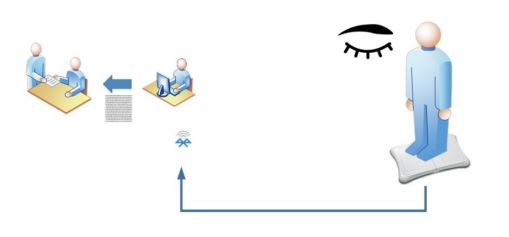Impaired Balance Assessment in Older People with Muscle Weakness Caused by Stroke
Main Article Content
Abstract
Stroke causes a severe impact in daily life movements. It affects a static balance in the human who has an impaired balance of their movement control. Assessing the evaluation criteria can be superseded via the movement, especially the Berg Balance scale, which is the gold standard in the assessment, even bringing a motion detector. To evaluate the balance assessment in stroke patient body, the physiotherapist uses the statistical methods to analyze the data. This research proposes the classification algorithm for evaluating the balance in the body of stroke patients with muscle weakness condition. It improves the algorithm’s accuracy in data prediction for measuring the validity of regaining balance while standing. The dataset has three main factors, including personal information, a diagnosis from a physiotherapist, and the performance standing on the Nintendo Wii Fit Balance Board. By evaluating with various scenario of different amount of attributes, the dataset with three attributes has the highest accuracy rate. Classifying information is used as a guideline in assessing the information on how to regain a patient’s balance control during standing. The most accurate classification method is the Artificial Neural Network with accurate 93% of the times for prediction and classification.
Article Details

This work is licensed under a Creative Commons Attribution-NonCommercial-NoDerivatives 4.0 International License.
References
P. Prasatkul, "The Situation of the Thai Elderly 2014," The Foundation of Thai Gerontology Research and Development Institute (TGRI) and Institute for Population and Social Research, Mahidol University. Bangkok: Amarin Printing & Publishing, 2015.
National Statistical Office, Social Indicators 2015, Ministry of Information and Communication Technology, Bankok, Thailand, 2016.
A. Sangchan and Chitpanya C., "Relationships Between Blood Glucose Levels, Stress, and Fatigue of Stroke Patients", Huachiew Chalermprakiet University Journal, 21, pp.29-40, 2018.
World Health Organization. (2002). The world health report 2002: reducing risks, promoting healthy life. World Health Organization.
A. Meretoja, M. Acciarresi, R. O. Akinyemi, B. Campbell, D. Dowlatshahi, C. English, and S. Sato, "Stroke doctors: who are we? A World Stroke Organization survey," International Journal of Stroke, 12(8), pp.858-868, 2017.
K. Aho, P. Harmsen, S. Hatano, J. Marquardsen, V. Smirnov, T., Strsses, “Cerebrovascular disease in the community: result of a WHO collaborative study,” Bulletin of the World Health Organization,; 58(1), 1980, pp.113-30.
R. Shinton and G. Beevers, “Meta-analysis of relation between curette smoking and stroke,” BMJ, 298, 1989, pp.789-94.
C., Warlow, C., Sudlow, M., Dennis, J. Wardlaw and P., Sandercock “Stroke,” Lancet, 362, 2003, pp.1211-1224.
R. Louis, Caplan’s stroke: a clinical approach, The United States of America; 2000.
G. Gillen and A. Burkhardt, Stroke Rehabilitation A Function-Based Approach, New York: Columbia University, 1998.
C. L. M. Sudlow and C. P. Warlow, “Comparable studies of the incidence of stroke and its pathological types: results from an international collaboration,” Stroke, 28(3), 1997, pp.491-499.
V. L. Feigin, C. M. Lawes, D. A. Bennett and C. S. Anderson, “Stroke epidemiology: a review of population-based studies of incidence, prevalence, and case-fatality in the late 20th century,” The lancet neurology, 2(1), 2003, pp.43-53.
C. P. Warlow, J. Van Gijn, M. S. Dennis, J. M. Wardlaw, J. M. Bamford, G. J. Hankey and P. Rothwell, “Stroke: practical management,” John Wiley & Sons, 2011.
V. L. Feigin, “Stroke epidemiology in the developing world,” The Lancet, 2005, pp.365:2160-1.
P. M. Lavados, C. Sacks, L. Prina, A. Escobar, C. Tossi, F. Araya and G. Alvarez, “Incidence, 30-day case-fatality rate, and prognosis of stroke in Iquique, Chile: a 2-year community-based prospective study (PISCIS project),” The Lancet, 365(9478), 2005, pp.2206-2215.
T. Thom, N. Haase, W. Rosamond, V. J. Howard, J. Rumsfeld and S. Kittner, “Heart disease and stroke statistics—2006 update: a report from the American Heart Association Statistics Committee and Stroke Statistics Subcommittee,” Circulation, 113(6), 2006, pp.e85-e151.
Neyer J. R., Greenlund K. I., Denny C. H., et al. Div for Heart Disease and Stroke Prevention, National Center for chronic Disease Prevention and Health Promotion, CDC. 2007; 56(19); 469-76.
N. E. Mayo, N. Korner-Bitensky, F. Becker and P. Georges, “Predicting falls among patients in a rehabilitation hospital,” J Phys Med Rehabil, 1989, pp.139-46.
A. Viriyavejatkul, “Stroke in Asia: an epidemiological consideration,” Clinical Neuropharmacol, 13, 1990, pp.S26-23.
F. B. Horak, P. Esselman, M. E. Anderson and M. K. Lynch, "The effects of movement velocity, mass displaced, and task certainty on associated postural adjustments made by normal and hemiplegic individuals,” Journal of Neurology, Neurosurgery & Psychiatry, 47(9), 1984, pp.1020-1028.
A. Shumway-Cook, D. Anson and S. Haller, “Postural sway biofeedback: its effect on reestablishing stance stability in hemiplegic patients,” Archives of physical medicine and rehabilitation, 69(6), 1988, pp.395-400.
G., Gillen, “Stroke rehabilitation: a function-based approach,” Elsevier Health Sciences, 2015.
P. A. Goldie, T. M. Bach and O. M. Evans, “Force platform measures for evaluating postural control: reliability and validity,” Archives of physical medicine and rehabilitation, 70(7), 1989, pp.510-517.
C. M. Cirsten, A. Ptito and M. F. Levin, “Feedback and cognitive in arm motor skill reacquisition after stroke,” Stroke, 37, 2006, pp.1237-42.
P. C. B. Khong, S. Y. Hoi, E. Holroyd and W. Wang, “Nurses’ clinical decision making on adopting a wound clinical decision support system,” CIN: Computers, Informatics, Nursing, 33(7), 2015, pp.295-305.
P. E. Beeler, D. W. Bates and B. L. Hug, “Clinical decision support systems,” Swiss medical weekly, 144(5152), 2014.


